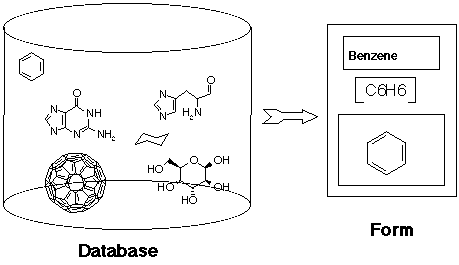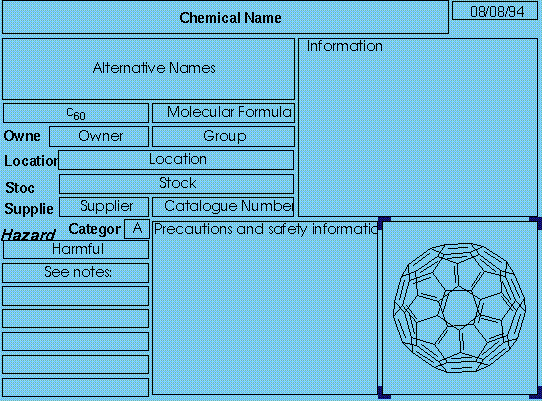|
|
| |
|
ISIS/base introduction
|
| |
| |
|
| |
| |
|
The Silicon Graphics Teaching Laboratory
has been replaced by the
Chemical Information Laboratory
and this information is for historical interest only
ISIS/Base Introduction
ISIS/Base is an hierarchical chemical database somewhat similar
to FileMaker Pro. Unlike FileMaker Pro, ISIS/Base was
designed with chemists in mind. The program is linked to
ISIS/Draw, so structures can easily be added to the database.
ISIS/Base will automatically calculate molecular formulae
and molecular weights from an ISIS/Draw structure.
In addition, ISIS/Base can search through a database
for substructures drawn by ISIS/Draw.
- Indigo only
Start ISIS/Base by typing isisbase. The first time
you run the program in any directory, it will copy a
configuration file into that directory.
Help
The program includes a comprehensive help system.
The Table of Contents page (ToC) is a good
place to begin. The Quick Reference section of
the table of contents page is particularly helpful.
- Databases
Several example databases are available. On a Macintosh
or a PC look for a folder or directory called Sample,
and open the files localmx or localrx.
- Browsing through a database
ISIS/Base usually starts in Query mode.
Choose Retrieve All from
the Search menu to bring the whole
database into view, then click on Browse
to look through it. Clicking on the arrows will move
you through the database. Clicking on the # sign will
let you go to a particular numbered entry.
- Forms
When browsing the database, you have a choice of several
different forms. These are windows to the database,
which present the information that interests you, and hides
the rest.

To change from one form to another, go to the
Database menu, and select Change Form.
You will be given a list of the forms that are available,
and you can select one by clicking on it.
- Structures
Some forms will show pictures of molecules. Double clicking
on such a picture will start ISIS/Draw running, and
you will be able to examine the structure (and rotate it
in 3D, if it has three-dimensional data available).
The program automatically calculated molecular formulae and
molecular weight from the picture of the molecule.
- Searching through the database
To search for a particular entry or series of entries
in the database, use the Query mode. In this mode
the Search menu has a Query Builder
item, that allows you to search for any word or
part of a word in any of the fields of the
current form. You can also draw structures or
substructures with ISIS/Draw, and search for these.
To search for a word in any field, enter the Query
mode, click in the area you want to search, and type
= "Buckminsterfullerene". The choose
By Form from the Search menu. This will
search the database for all records with the name
Buckminsterfullerene. (Capital letters are not considered.)
You may not know exactly what you are searching for.
If this is the case, use the like command.
Type like "%minster%", then search by form.
The '%' character is a wildcard, which will match
anything, so you may find Buckminsterfullerene,
York Minster, Beverly Minster, and anything else
in the database containing this sequence of letters.
Many other options are available. Using the Query
Builder (in the Search menu should help.
- Updating the database
The Update mode allows you to edit data
make new records.
- Designing forms
The Layout mode allows you to edit forms, and
to design new forms, more suitable for your particular
needs.
- Laboratory Chemicals
There is a database of thousands of the chemicals in
use in the laboratory, with some of their safety
data. A template for this database is available on
the Silicon Graphics workstations:
/usr/local/mdl/LabChemTemplate.db
Type isisbase /usr/local/mdl/LabChemTemplate.db
to see this.
This is a picture of the database running on an Indigo.

|
| | |
| |
| |
| |
| |
|
|